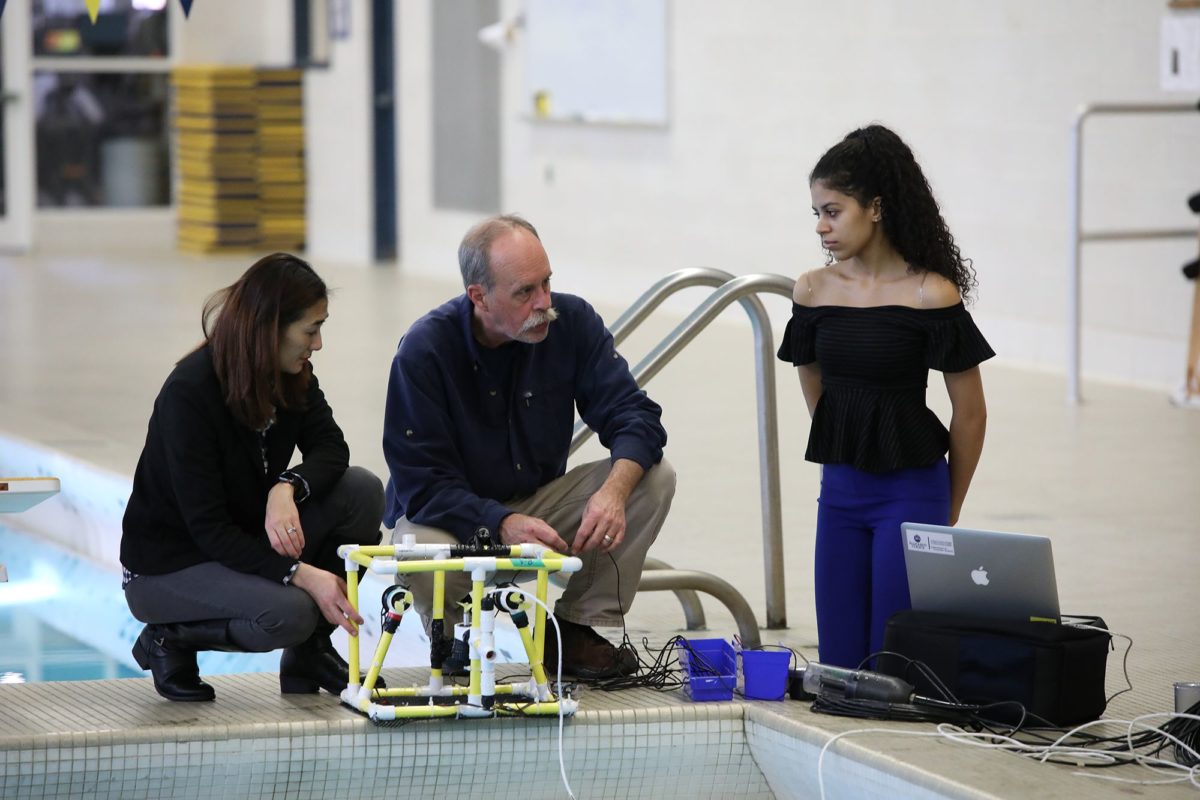
Allegheny Faculty-Student Team Helps Develop Underwater Robots to Perform Lake Research
David Boughton of Penn State’s Sea Grant College program last summer was looking for a way to collect more encompassing data when he samples water quality in lakes in northwest Pennsylvania, including the murky expanses of Lake Erie.
So he sought the help of Allegheny College Computer Science Professor Janyl Jumadinova and one of her students to help design and build research robots that have the capability to take waterproof sensors underwater for several hours at a time and transmit a bounty of data.
“David wanted to send robots to different depths and collect a range of data over a period of hours as opposed to just dropping a sensor overboard on a line and taking a random sample,” says Jumadinova.
And so the partnership began with Boughton, the engineer, working on the mechanical aspects of the robot, and Jumadinova and student Elisia Wright ’21, the software experts, working on the sensor unit to function as the robot’s eyes, ears and brain, so to speak.
Video description: underwater robot demonstration
“The most challenging aspects of this project are working with the sensors and envisioning how everything will function together,” says Wright, who is a computer science and environmental studies double major. “Currently, we are working on combining the code required for each of the sensors so that it will be more efficient when testing and gathering data.”
The team is developing a prototype and tested it in the Mellon Pool in the David V. Wise Sport & Fitness Center this winter and hopes to deploy it in the depths of Lake Erie in the spring of 2019.
An Academic Partnership
The project started as a part of the Allegheny College-Crawford Central School District STEM Partnership program organized by Allegheny Biology Professor Lisa Whitenack, where instructors from Allegheny and Crawford Central were paired to explore their curricular connections.
Boughton, a maritime education specialist who is employed by Penn State, teaches 24 middle-school students enrolled in enrichment programs about underwater robotics in the basement laboratories of Allegheny’s Alden Hall on Fridays. In the spring, he takes them onto a research vessel off Lake Erie’s Presque Isle to conduct water-quality testing.
The robot project is helping to “build a bridge” between the middle school students and Allegheny College, says Boughton.
“Whatever we’re doing for research, we try to make into an educational opportunity,” he adds.
Since the summer, the project expanded beyond the curriculum discussions and building classroom prototypes into a research project that seeks to contribute to a community need.
“This effort is to customize the robots for whatever it is we want to do — carry cameras for near-shore surveys, sample water and/or sediment, conduct fish counts and survey shipwrecks. We can also have some fun with them putting a turtle shell or a duck decoy over the robot,” Boughton says.
The sensor unit being developed by Jumadinova and Wright will consist of sensors that test for temperature, pH, oxygen content and conductivity on a continuous basis in depths down to 30 or 40 feet.
“Right now, Elisia is writing the programs to gather data from the sensors, and we are developing an algorithm for aggregating the data from multiple sensors. With the help of environmental water experts, we want to automate data analysis and develop the software to analyze the data. The engineering key, of course, is to develop a watertight unit,” Jumadinova says.
Data Interpretation Is Key
Adding sensors to the underwater robots, “has upped my game,” says Boughton. “It will allow the water quality sensing unit to go places and collect data where we couldn’t before. We’ll be able to collect and store data from different levels of the water column, and with help from Allegheny, we can interpret this data, share with other researchers and help students understand variations in water quality measurements.”
Wright, who is from Mount Laurel, New Jersey, has immersed herself in the project. “The project allows me to combine two areas of interest that I am passionate about. I love the hands-on aspect of actually building the robot itself, as well as developing the software to control it. I have always been fascinated by aquatic ecosystems since I was young, specifically freshwater. After learning how, and then building my own computer, I became very interested in coding and developing software,” she says.
The partnership also has led to an internship for Wright for the upcoming summer. “As I continue my studies at Allegheny, I plan to become more involved in research involving computer science and the environment,” she says. “For the summer of 2019, I will be working under David Boughton as a Lake Erie Shipboard Science Education program educator. I will also continue working as a research assistant under Allegheny Environmental Science Professor Rich Bowden. As for the future, I intend to go to graduate school and hope to work on other educational opportunities.”
Photo caption: Allegheny College Computer Science Professor Janyl Jumadinova, David Boughton of Penn State’s Sea Grant College, and Allegheny student Elisia Wright test the research robot in the Mellon Pool on campus.
Photo Credit: Ed Mailliard